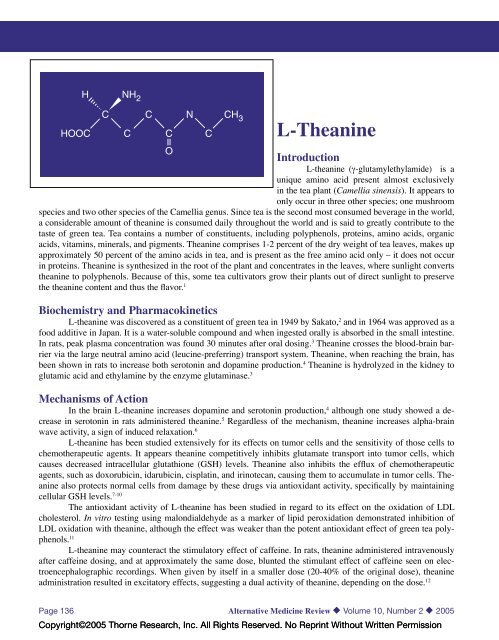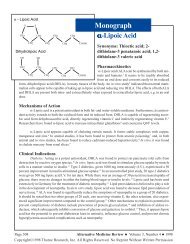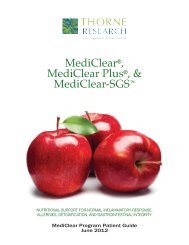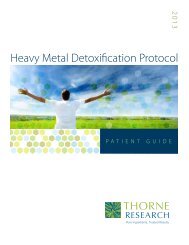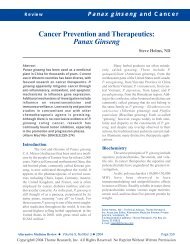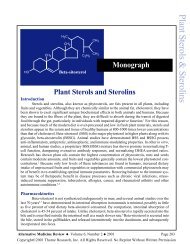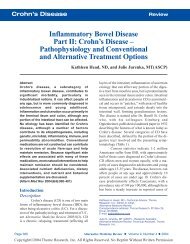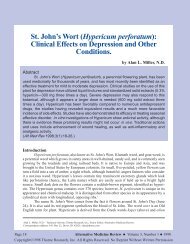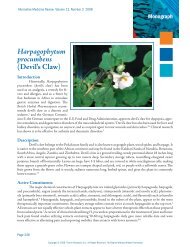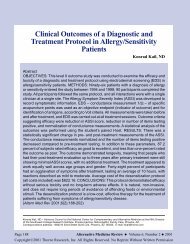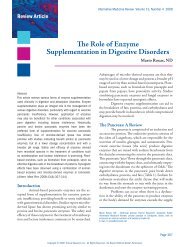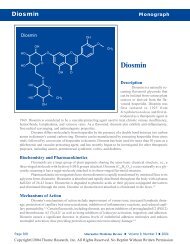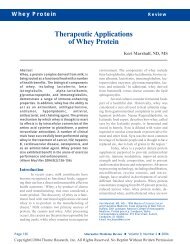L-Theanine - Thorne Research
L-Theanine - Thorne Research
L-Theanine - Thorne Research
Create successful ePaper yourself
Turn your PDF publications into a flip-book with our unique Google optimized e-Paper software.
<strong>Theanine</strong><br />
Monograph<br />
HOOC<br />
H NH 2<br />
C<br />
C<br />
C<br />
C<br />
N<br />
C<br />
CH 3<br />
L-<strong>Theanine</strong><br />
O<br />
Introduction<br />
L-theanine (γ-glutamylethylamide) is a<br />
unique amino acid present almost exclusively<br />
in the tea plant (Camellia sinensis). It appears to<br />
only occur in three other species; one mushroom<br />
species and two other species of the Camellia genus. Since tea is the second most consumed beverage in the world,<br />
a considerable amount of theanine is consumed daily throughout the world and is said to greatly contribute to the<br />
taste of green tea. Tea contains a number of constituents, including polyphenols, proteins, amino acids, organic<br />
acids, vitamins, minerals, and pigments. <strong>Theanine</strong> comprises 1-2 percent of the dry weight of tea leaves, makes up<br />
approximately 50 percent of the amino acids in tea, and is present as the free amino acid only – it does not occur<br />
in proteins. <strong>Theanine</strong> is synthesized in the root of the plant and concentrates in the leaves, where sunlight converts<br />
theanine to polyphenols. Because of this, some tea cultivators grow their plants out of direct sunlight to preserve<br />
the theanine content and thus the flavor. 1<br />
Biochemistry and Pharmacokinetics<br />
L-theanine was discovered as a constituent of green tea in 1949 by Sakato, 2 and in 1964 was approved as a<br />
food additive in Japan. It is a water-soluble compound and when ingested orally is absorbed in the small intestine.<br />
In rats, peak plasma concentration was found 30 minutes after oral dosing. 3 <strong>Theanine</strong> crosses the blood-brain barrier<br />
via the large neutral amino acid (leucine-preferring) transport system. <strong>Theanine</strong>, when reaching the brain, has<br />
been shown in rats to increase both serotonin and dopamine production. 4 <strong>Theanine</strong> is hydrolyzed in the kidney to<br />
glutamic acid and ethylamine by the enzyme glutaminase. 3<br />
Mechanisms of Action<br />
In the brain L-theanine increases dopamine and serotonin production, 4 although one study showed a decrease<br />
in serotonin in rats administered theanine. 5 Regardless of the mechanism, theanine increases alpha-brain<br />
wave activity, a sign of induced relaxation. 6<br />
L-theanine has been studied extensively for its effects on tumor cells and the sensitivity of those cells to<br />
chemotherapeutic agents. It appears theanine competitively inhibits glutamate transport into tumor cells, which<br />
causes decreased intracellular glutathione (GSH) levels. <strong>Theanine</strong> also inhibits the efflux of chemotherapeutic<br />
agents, such as doxorubicin, idarubicin, cisplatin, and irinotecan, causing them to accumulate in tumor cells. <strong>Theanine</strong><br />
also protects normal cells from damage by these drugs via antioxidant activity, specifically by maintaining<br />
cellular GSH levels. 7-10<br />
The antioxidant activity of L-theanine has been studied in regard to its effect on the oxidation of LDL<br />
cholesterol. In vitro testing using malondialdehyde as a marker of lipid peroxidation demonstrated inhibition of<br />
LDL oxidation with theanine, although the effect was weaker than the potent antioxidant effect of green tea polyphenols.<br />
11<br />
L-theanine may counteract the stimulatory effect of caffeine. In rats, theanine administered intravenously<br />
after caffeine dosing, and at approximately the same dose, blunted the stimulant effect of caffeine seen on electroencephalographic<br />
recordings. When given by itself in a smaller dose (20-40% of the original dose), theanine<br />
administration resulted in excitatory effects, suggesting a dual activity of theanine, depending on the dose. 12<br />
Page 136 Alternative Medicine Review ◆ Volume 10, Number 2 ◆ 2005<br />
Copyright©2005 <strong>Thorne</strong> <strong>Research</strong>, Inc. All Rights Reserved. No Reprint Without Written Permission
Monograph<br />
<strong>Theanine</strong><br />
A dose-dependent hypotensive effect of theanine<br />
was seen in vivo in spontaneously hypertensive<br />
rats injected with L-theanine. 13 Glutamine (which is<br />
structurally similar to theanine) administration did<br />
not alter the blood pressure. 14<br />
Clinical Indications<br />
Stress/Anxiety<br />
Studies show L-theanine induces alpha-brain<br />
wave activity, which correlates with a perceived state<br />
of relaxation. A small Japanese study of university<br />
students showed oral L-theanine administration of<br />
200 mg led to increased alpha-brain waves and a subjective<br />
sense of relaxation. <strong>Theanine</strong> administration<br />
caused a dose-dependent relaxed, yet alert, state of<br />
mind without sedation, beginning approximately 40<br />
minutes after oral dosing. 6<br />
Green tea is often used as a relaxing beverage,<br />
although it can contain more caffeine than coffee.<br />
<strong>Theanine</strong> appears to counteract the stimulant effect<br />
of caffeine to some degree. 12<br />
Hypertension<br />
In studies of spontaneously hypertensive<br />
rats, L-theanine administration caused a significant<br />
reduction in blood pressure. 15,16 Whether humans will<br />
experience similar results has yet to be determined;<br />
however, theanine might find a place in antihypertensive<br />
treatment regimens.<br />
Cancer<br />
Numerous in vitro and animal studies have<br />
investigated L-theanineʼs effect on cancer. <strong>Theanine</strong><br />
decreased the size of ovarian tumors in M5076 ovarian<br />
sarcoma-bearing mice, when given in conjunction<br />
with chemotherapeutics, including doxorubicin, idarubicin,<br />
pirarubicin, cisplatin, and irinotecan. 7-10,15 L-<br />
theanine, given along with doxorubicin, reduced the<br />
size of ovarian tumors and decreased metastases to<br />
the liver as well. 15 In another study, theanine almost<br />
doubled the effect of doxorubicin in Erlich ascites<br />
carcinoma, while increasing the drugʼs concentration<br />
in tumor cells threefold. 16 It appears theanine exerts<br />
an additive effect along with chemotherapy by reducing<br />
transport of glutamic acid into the cell, decreasing<br />
GSH levels in the cell, and increasing the<br />
concentration of the drug in tumor cells. <strong>Theanine</strong><br />
also protects normal cells from damage by chemotherapeutic<br />
drugs. 7-10<br />
Drug-Nutrient Interactions<br />
L-theanine increases the activity of doxorubicin,<br />
idarubicin, pirarubicin, cisplatin, and irinotecan<br />
in tumor cells. 7-10,15<br />
Side Effects and Toxicity<br />
L-theanine is generally well tolerated, and<br />
has an LD 50<br />
of greater than 5,000 mg/kg in rats. It<br />
is not mutagenic or carcinogenic in animals or bacteria.<br />
Dosage and Administration<br />
For relaxation, 200 mg L-theanine can be<br />
taken 2-3 times daily. For cancer in conjunction with<br />
chemotherapy the dose is speculative, as no human<br />
studies have been performed. However, a dosage of<br />
400-800 mg three times daily can be used safely.<br />
References<br />
1. Juneja LR, Chu D, Okubo T, et al. L-theanine – a<br />
unique amino acid of green tea and its relaxation<br />
effect in humans. Food Sci Tech 1999;10:199-204.<br />
2. Sakato Y. The chemical constituents of tea: III. A<br />
new amide theanine. Nippon Nogeikagaku Kaishi<br />
1949;23:262-267.<br />
3. Unno T, Suzuki Y, Kakuda T, et al. Metabolism of<br />
theanine, a gamma-glutamylethylamide, in rats. J<br />
Agric Food Chem 1999;47:1593-1596.<br />
4. Yokogoshi H, Kobayashi M, Mochizuki<br />
M, Terashima T. Effect of theanine, r-<br />
glutamylethylamide, on brain monoamines<br />
and striatal dopamine release in conscious rats.<br />
Neurochem Res 1998;23:667-673.<br />
5. Yokogoshi H, Mochizuki M, Saitoh K. <strong>Theanine</strong>induced<br />
reduction of brain serotonin concentration<br />
in rats. Biosci Biotechnol Biochem 1998;62:816-<br />
817.<br />
6. Ito K, Nagato Y, Aoi N, et al. Effects of L-<br />
theanine on the release of alpha-brain waves in<br />
human volunteers. Nippon Nogeikagaku Kaishi<br />
1998;72:153-157.<br />
7. Sugiyama T, Sadzuka Y. <strong>Theanine</strong> and glutamate<br />
transporter inhibitors enhance the antitumor<br />
efficacy of chemotherapeutic agents. Biochim<br />
Biophys Acta 2003;1653:47-59.<br />
Alternative Medicine Review ◆ Volume 10, Number 2 ◆ 2005 Page 137<br />
Copyright©2005 <strong>Thorne</strong> <strong>Research</strong>, Inc. All Rights Reserved. No Reprint Without Written Permission
<strong>Theanine</strong><br />
Monograph<br />
8. Sadzuka Y, Sugiyama T, Suzuki T, Sonobe T.<br />
Enhancement of the activity of doxorubicin by<br />
inhibition of glutamate transporter. Toxicol Lett<br />
2001;123:159-167.<br />
9. Sugiyama T, Sadzuka Y, Nagasawa R, et al.<br />
Membrane transport and antitumor activity<br />
of pirarubicin, and comparison with those of<br />
doxorubicin. Jpn J Cancer Res 1999;90:775-780.<br />
10. Sugiyama T, Sadzuka Y. <strong>Theanine</strong>, a specific<br />
glutamate derivative in green tea, reduces the<br />
adverse reactions of doxorubicin by changing the<br />
glutathione level. Cancer Lett 2004;212:177-184.<br />
11. Yokozawa T, Dong E. Influence of green tea<br />
and its three major components upon lowdensity<br />
lipoprotein oxidation. Exp Toxicol Pathol<br />
1997;49:329-335.<br />
12. Kakuda T, Nozawa A, Unno T, et al. Inhibiting<br />
effects of theanine on caffeine stimulation<br />
evaluated by EEG in the rat. Biosci Biotechnol<br />
Biochem 2000;64:287-293.<br />
13. Yokogoshi H, Kobayashi M. Hypotensive effect<br />
of gamma-glutamylmethylamide in spontaneously<br />
hypertensive rats. Life Sci 1998;62:1065-1068.<br />
14. Yokogoshi H, Kato Y, Sagesaka YM, et al.<br />
Reduction effect of theanine on blood pressure<br />
and brain 5-hydroxyindoles in spontaneously<br />
hypertensive rats. Biosci Biotechnol Biochem<br />
1995;59:615-618.<br />
15. Sugiyama T, Sadzuka Y. Combination of theanine<br />
with doxorubicin inhibits hepatic metastasis<br />
of M5076 ovarian sarcoma. Clin Cancer Res<br />
1999;5:413-416.<br />
16. Sadzuka Y, Sugiyama T, Miyagishima A, et al.<br />
The effects of theanine, as a novel biochemical<br />
modulator, on the antitumor activity of adriamycin.<br />
Cancer Lett 1996;105:203-209.<br />
Page 138 Alternative Medicine Review ◆ Volume 10, Number 2 ◆ 2005<br />
Copyright©2005 <strong>Thorne</strong> <strong>Research</strong>, Inc. All Rights Reserved. No Reprint Without Written Permission


